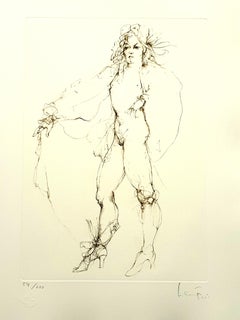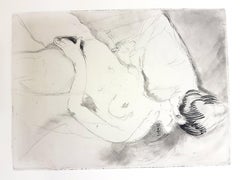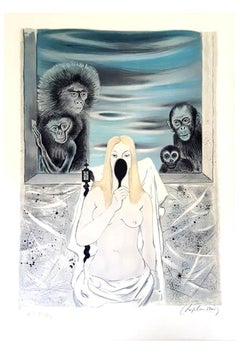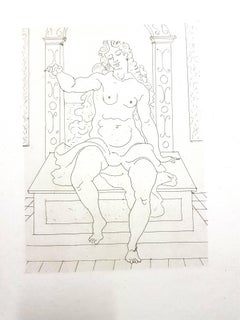Switzerland - Nude Prints
to
2
144
24
24
2
Overall Width
to
Overall Height
to
98
71
16
1
61
34
18
16
14
194
2
15
23
5
31
81
19
15
180
14
168
131
106
73
43
42
39
33
27
10
7
5
5
4
3
3
3
2
2
2
112
72
10
2
3
194
1,295
1,087
Item Ships From: Switzerland
Leonor Fini - Fearless - Original Handsigned Lithograph
By Leonor Fini
Located in Collonge Bellerive, Geneve, CH
Leonor Fini - Fearless - Original Handsigned Lithograph
Les Elus de la Nuit
1986
Conditions: excellent
Handsigned and Numbered
Edition: 230
Dimensions: 38 x 28 cm
Editions: Trinckve...
Category
1980s Modern Switzerland - Nude Prints
Materials
Lithograph
Leonor Fini - Walking Dead - Original Lithograph
By Leonor Fini
Located in Collonge Bellerive, Geneve, CH
Leonor Fini - Walking Dead - Original Lithograph
The Flowers of Evil
1964
Conditions: excellent
Edition: 500
Dimensions: 46 x 34 cm
Editions: Le Cercle ...
Category
1960s Modern Switzerland - Nude Prints
Materials
Lithograph
Jean Gabriel Domergue - Women's Love - Original Etching
By Jean-Gabriel Domergue
Located in Collonge Bellerive, Geneve, CH
Original Etching by Jean-Gabriel Domergue
Dimensions: 33 x 25 cm
1924
Edition of 100
This artwork is part of the famous portfolio The Afternoon of a Faun.
Unsigned and unnumbered as ...
Category
1920s Impressionist Switzerland - Nude Prints
Materials
Lithograph
Leonor Fini - Sitting - Original Lithograph
By Leonor Fini
Located in Collonge Bellerive, Geneve, CH
Leonor Fini - Sitting - Original Lithograph
The Flowers of Evil
1964
Conditions: excellent
Edition: 500
Dimensions: 46 x 34 cm
Editions: Le Cercle du Livre Précieux, Paris
Unsigned...
Category
1960s Modern Switzerland - Nude Prints
Materials
Lithograph
Roger Chapelain-Midy - Original Handsigned Lithograph - Ecole de Paris
By Roger Chapelain Midy
Located in Collonge Bellerive, Geneve, CH
Roger Chapelain-Midy
Original Handsigned Lithograph
Dimensions: 76 x 54 cm
Edition: HC XXI/XXX
HandSigned and Numbered
Ecole de Paris au seuil de la mutation des Arts
Sentiers Editi...
Category
1970s Modern Switzerland - Nude Prints
Materials
Lithograph
André Derain - Ovid's Heroides - Original Etching
By André Derain
Located in Collonge Bellerive, Geneve, CH
André Derain - Ovid's Heroides
Original Etching
Edition of 134
Dimensions: 32 x 25 cm
Ovide [Marcel Prevost], Héroïdes, Paris, Société des Cent-une, 1938...
Category
1930s Modern Switzerland - Nude Prints
Materials
Etching
André Derain - Ovid's Heroides - Original Etching
By André Derain
Located in Collonge Bellerive, Geneve, CH
André Derain - Ovid's Heroides
Original Etching
Edition of 134
Dimensions: 32 x 25 cm
Ovide [Marcel Prevost], Héroïdes, Paris, Société des Cent-une, 1938...
Category
1930s Modern Switzerland - Nude Prints
Materials
Etching
André Derain - Ovid's Heroides - Original Etching
By André Derain
Located in Collonge Bellerive, Geneve, CH
André Derain - Ovid's Heroides
Original Etching
Edition of 134
Dimensions: 32 x 25 cm
Ovide [Marcel Prevost], Héroïdes, Paris, Société des Cent-une, 1938...
Category
1930s Modern Switzerland - Nude Prints
Materials
Etching
Leonor Fini - Friends - Original Handsigned Lithograph
By Leonor Fini
Located in Collonge Bellerive, Geneve, CH
Leonor Fini - Friends - Original Handsigned Lithograph
Les Elus de la Nuit
1986
Conditions: excellent
Handsigned and Numbered
Edition: 230
Dimensions: 38 x 28 cm
Editions: Trinckvel...
Category
1980s Modern Switzerland - Nude Prints
Materials
Lithograph
Leonor Fini - Red-Haired Girl - Original Lithograph
By Leonor Fini
Located in Collonge Bellerive, Geneve, CH
Leonor Fini - Red-Haired Girl - Original Lithograph
The Flowers of Evil
1964
Conditions: excellent
Edition: 500
Dimensions: 46 x 34 cm
Editions: Le Cercle du Livre Précieux, Paris
...
Category
1960s Modern Switzerland - Nude Prints
Materials
Lithograph
André Derain - Ovid's Heroides - Original Etching
By André Derain
Located in Collonge Bellerive, Geneve, CH
André Derain - Ovid's Heroides
Original Etching
Edition of 134
Dimensions: 32 x 25 cm
Ovide [Marcel Prevost], Héroïdes, Paris, Société des Cent-une, 1938
Andre Derain was born in 1...
Category
1930s Modern Switzerland - Nude Prints
Materials
Etching
André Derain - Ovid's Heroides - Original Etching
By André Derain
Located in Collonge Bellerive, Geneve, CH
André Derain - Ovid's Heroides
Original Etching
Edition of 134
Dimensions: 32 x 25 cm
Ovide [Marcel Prevost], Héroïdes, Paris, Société des Cent-une, 1938
Andre Derain was born in 1...
Category
1930s Modern Switzerland - Nude Prints
Materials
Etching
Jacques Villon - Nude - Original Etching
By Jacques Villon
Located in Collonge Bellerive, Geneve, CH
Jacques Villon - Nude - Original Etching
1947
Signed in pencil and numbered
Dimensions : 55.6 x 39.5 cm
Category
1940s Modern Switzerland - Nude Prints
Materials
Etching
André Derain - Ovid's Heroides - Original Etching
By André Derain
Located in Collonge Bellerive, Geneve, CH
André Derain - Ovid's Heroides
Original Etching
Edition of 134
Dimensions: 32 x 25 cm
Ovide [Marcel Prevost], Héroïdes, Paris, Société des Cent-une, 1938
Andre Derain was born in 1...
Category
1930s Modern Switzerland - Nude Prints
Materials
Etching
Recently Viewed
View AllMore Ways To Browse
William Didier Pouget
William Gaw
William S Horton
William Secord Gallery
William Skilling Monkey
William Stewart Macgeorge
Willy Eisenschitz
Yorkshire House Inc
Zhang Zhengdao
Zoe Mozert
A H Vickers Oil Painting
Aaron Bushnell
Aaron Garber Maikovska
Abraham Herbe
Abraham Rosenthal
Acrylic Nutcracker
Adrian Allinson
Adrian Berg





